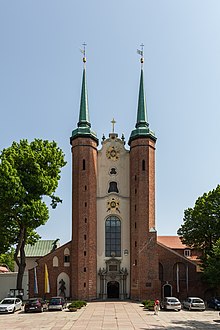Oliva Cathedral

The Oliva Cathedral (Polish: Kościół pod wezwaniem Trójcy Świętej, Najświętszej Maryi Panny i Świętego Bernarda ) (Church of the Holy Trinity , Most Holy Virgin Mary and Saint Bernard of Clairvaux ) is located in the Oliva district of Gdańsk .
architecture
The cathedral is a three-aisled basilica with a transept and a polygonal choir with ambulatory .
The facade is flanked by two slender towers, each 46 meters high, with pointed baroque helmet roofs, at this height unusual for Cistercian churches. The entrance leads through a baroque portal from 1688. The crossing carries a bell tower (roof turret), which is typical for Cistercian churches.
The total length is 107 meters (external dimensions) and 97.6 meters (internal dimensions). It is the longest Cistercian church building in the world.
history
The Cistercians built a monastery "ad montem Olivarum" in 1186 with the consent of the Dukes of Pomerania . The first Romanesque church was burned down by the Prussians in 1224 , rebuilt and expanded by the monks, and burned down again by the Prussians in 1234 (or 1236). In 1350 the monastery and the church fell victim to the flames again. In the second half of the 14th century a Gothic church was built in its current form. There are, however, some Romanesque and early Gothic sites that were built under the Pomeranian dukes.
In 1831 the Cistercian order was liquidated by the Prussian authorities and the Oliva monastery was closed. The church and part of the monastery were assigned to the Catholic parish.
In 1925 Pope Pius XI established a diocese of Danzig . The church at Oliva was elevated to the status of a cathedral and Oliva became the administrative seat of the diocese and the bishopric. In 1976 the church was given by Pope Paul VI. awarded the title of a minor basilica .
Furnishing
In the interior there are 23 mostly high and late baroque altars. The old high altar (1605) in the style of the Dutch Renaissance was replaced by a baroque altar in 1699, which is considered a masterpiece of the Pomeranian Baroque. In 1615 Abraham van den Blocke (1572–1628) created the tomb of the Koss family with four life-size figures made of white and black marble kneeling in front of a small crucifix.
The pictures are works by Herman Han (1574–1628), Adolf Boy (1612–1680), Andreas Stech (1635–1697) and Andreas Schlueter (1660–1714). The chapels are dedicated to St. John Nepomuk and the Holy Cross.
- Inside the cathedral
Organs
There are three organs in the cathedral : the large organ on the west gallery above the entrance, a positive in a west arcade and a side organ at the south end of the transept. Together they are the fourth largest organ in Poland with 111 stops. The prospectus of the main organ from 1763/93 is the largest preserved baroque prospectus in the world. The prospectus of the small organ is from 1680. The large organ has been preserved in parts from 1793 and has been rebuilt several times. The side organ was newly installed in 2003.
Web links
literature
- Stefan Samerski : The diocese of Danzig in life pictures. 2003, ISBN 3-8258-6284-4 .
- Zygmunt Iwicki : Oliva. Guide to the cathedral and the former monastery. Laumann-Verlag, Dülmen 1994, ISBN 3-87466-220-9 .
See also
Individual evidence
- ↑ Bazylika Archikatedralna Świętej Trójcy on gcatholic.org
Coordinates: 54 ° 24 ′ 39.7 ″ N , 18 ° 33 ′ 32.1 ″ E









